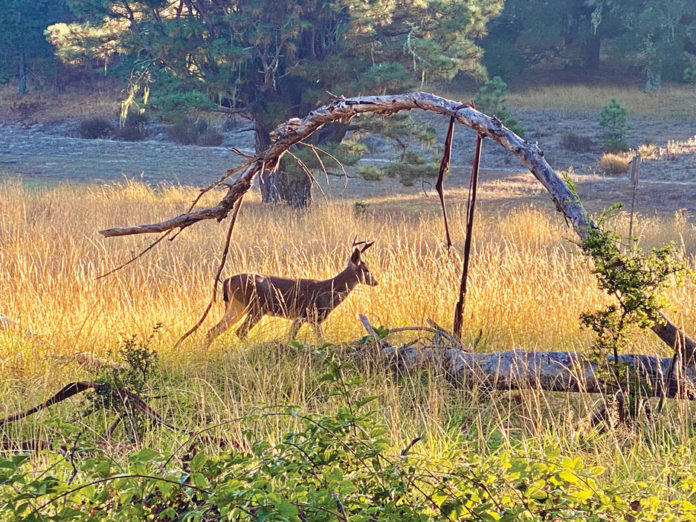
I thought my plants were safe from deer. Because most of my sunny spots are in front, I planted lots of colorful annuals and perennials out there. Then a couple months ago, all my snapdragon flower spikes were eaten overnight. I was stymied. I live in a condominium complex, after all. Then the buds of my agapanthus were severed and the snapdragons for the second time. It was then that my neighbor told me she had captured a young buck on her security camera heading right for my plants.
So I now spray with Squirrel Stopper (I have a squirrel problem, too) as it’s similar to some of the deer repellents with rosemary oil, corn mint oil, putrescent eggs solids and cinnamon oil. I don’t need to spray the zinnias, cosmos, geraniums, petunias or even the large hostas, just the snapdragons. Picky deer, I guess. But are there any other safe plants that deer seem to avoid?
There are native plants that are poisonous for us but only some of them are avoided by deer. It got me thinking. How do deer eat poisonous plants without apparent ill affect?
Deer are browsers. They thrive on a mixed diet. You’ve seen them eat a few roses then saunter over to the abutilon and then on to the daylily flowers. Deer will eat almost anything, even plants with a strong scent like catmint, lavender, or thyme when they are hungry or need water. They can even eat a few bites of various toxic plants.
According to Tom Hanley, a wildlife biologist with the Forest Service Pacific Northwest Research Station, “There seems to be threshold levels for the toxicity of different plants, and as long as deer eat below that threshold, they’re OK.” Plant toxicity varies with the time of year also and flowers may be less toxic than leaves or roots. They just mix it up.
That explains the eating habits of deer but what about us?
Many of us are including native plants in our landscapes to attract wildlife and save water and resources. Here are some common native plants that you should be aware of if you have small children. This list comes from Borstein, Foss and O’Brian, “California Native Plants for the Garden.”
• Coffeeberry—leaves, berries and bark
• California buckeye—all parts (poisonous to bees also)
• Western azalea—all parts
• Elderberry—all parts except ripe berries and fruit
• Solanum—all parts
• Snowberry—berries
• California buttercup—juice of the plant
• Berberis—roots and leaves
• Prunus (cherry)—seeds
• California poppy—all parts
• Lupine (annual)—seeds, fresh leaves and stems.
Mostly though, native plants make great additions to the garden. They tend to be well behaved and are rarely invasive. Birds and butterflies rely on them for food, shelter and nesting. And best of all they are beautiful.
When I’m designing with native plants I find the following plants are fairly safe around deer. They are not perfectly safe at all times of the year but they are usually avoided.
• Artemisia also called Ca. sagebrush
• Asarum—Wild ginger
• Baccharis—Dwf coyote brush
• Ceanothus “Julia Phelps”
• Eriogonum—Ca. buckwheat
• Douglas iris
• Mimulus auritanicus—Sticky monkey flower
• Monardella—Coyote mint
• Ribes speciosum—Fuchsia-flowering gooseberry
• Salvia
Enjoy your garden. Let the deer browse elsewhere and be aware of plants that may be toxic to children.
Next week I’ll give you some good techniques that help deter deer.
Jan Nelson, a landscape designer and California-certified nursery professional, will answer questions about gardening in the Santa Cruz Mountains. Email her at ja******@*ol.com, or visit jannelsonlandscapedesign.com.











